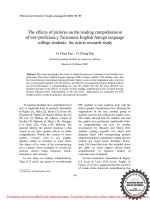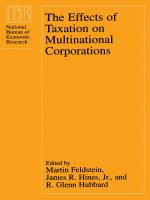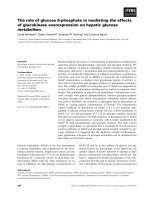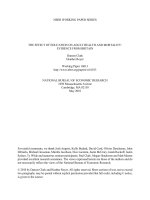Osteoporosis in Men: The Effects of Gender on Skeletal Health pot
Bạn đang xem bản rút gọn của tài liệu. Xem và tải ngay bản đầy đủ của tài liệu tại đây (29.64 MB, 611 trang )
Osteoporosis in Men
This Page Intentionally Left Blank
Osteoporosis
in Men
The Effects of Gender
on Skeletal Health
Edited by
Eric S. Orwoll
Oregon Health Sciences University
Portland VA Medical Center
Portland, Oregon
ACADEMIC PRESS
San Diego London Boston New York
Sydney Tokyo Toronto
Front cover photograph:
Histological section of the vertebral body edge
from an 82-year-old woman. For more details, see Figure 4 (color insert)
in Chapter 16.
This book is printed on acid-free paper. (~)
Copyright ~3 1999 by ACADEMIC PRESS
All Rights Reserved.
No part of this publication may be reproduced or transmitted in any form or by any
means, electronic or mechanical, including photocopy, recording, or any information
storage and retrieval system, without permission in writing from the publisher.
Requests for permission to make copies of any part of the work should be mailed to:
Permissions Department, Harcourt Brace & Company, 6277 Sea Harbor Drive,
Orlando, Florida, 32887-6777.
Academic Press
a division o['Harcourt Brace & Company
525 B Street, Suite 1900, San Diego, California 92101-4495, USA
Academic Press
24-28 Oval Road, London NWI 7DX, UK
Library of Congress Catalog Card Number: 99-83125
International Standard Book Number: 0-12-528640-6
PRINTED IN THE UNITED STATES OF AMERICA
99 00 01 02 03 04 EB 9 8 7 6 5 4 3 2 1
Contents
Contributors xix
Preface xxiii
Chapter
I
Epidemiology
of
Fractures
L.
Joseph
Melton
111
I.
Introduction
1
11.
Effects
of
Age
2
111. Effects
of
Gender
3
IV. Effects
of
Race 4
V. Effects
of
Geography
6
VI.
Secular Trends
7
VII. Public Health Implications
8
References
9
Chapter
2
Economic Impact
of
Fractures
Anna
N.
A.
Tosteson
I.
Introduction
15
11.
Economic Evaluation
16
A.
Cost
of
Illness Studies
16
V
vi
Contents
B. Cost-EffectivenessAnalysis 16
III. Definition of Costs 17
A. Direct Costs 17
B. Indirect Costs 17
C. Intangible Costs 18
IV. Review of Studies 18
A. Cost of Illness Studies 19
B. Cost-Effectiveness Studies 23
V. Summary of Findings 24
VI. Directions for Future Research 25
References 25
Chapter 3
Hip and Vertebral Fractures
Frazer H. Anderson and Cyrus Cooper
I. Introduction 29
II. Demographic Factors 30
III. Gender-Specific Factors 31
A. Skeletal Growth 32
B. Hormonal Influences in Adult Life 33
C. Trauma 34
IV. Factors Affecting Case Definition 34
A. RadiologicaluMorphometric 34
B. RadiologicaluDensitometric 34
C. Clinical 35
V. Social and Economic Factors 36
A. Occupation 37
B. Diet 38
C. Exercise 39
D. Leisure Activities 39
VI. Falls 39
VII. Consequencs of Osteoporotic Vertebral and Femoral Fracture
VIII. Intervention 42
A. Pain Control 42
B. Surgery 43
C. Reduction of Falls Risk 43
D. Reduction of Forces Acting at the Impact Site 44
IX. Future Trends 44
References 45
41
Contents
vii
Chapter 4
Outcomes and the Personal Impact of Osteoporosis
Deborah T. Gold
I. Introduction 51
A. Osteoporosis and Men: What We Know 52
B. Osteoporosis: Its Social/Emotional Impact and Quality
of Life 55
II. Men and Osteoporosis-Where Do We Start to Understand
Outcomes? 58
A. Focus Groups 58
B. Instrumentation 59
III. Commentary 59
IV. Conclusion 60
References 60
Chapter 5
Accumulation of Bone Mass during Childhood
and Adolescence
Vicente
Gilsanz
I. Introduction 65
II. Techniques for Bone Measurements in Children 66
Ill. Peak Bone Mass 67
IV. Age-Related Changes in the Axial and Appendicular Skeletons
V. Nutrition 70
VI. Physical Activity 71
VII. Genetics 73
VIII. Gender 74
IX. Race 77
X. Conclusion 79
References 80
68
Chapter 6
Bone Size, Mass, and Volumetric Density: The Importance
of Structure in Skeletal Health
Ego Seeman
I. Introduction 87
II. Comparing Men and Women of Different Races 88
viii
Contents
A. Growth in Size, Mass, and Volumetric Density of the Axial
Skeleton 88
B. Growth in Size, Mass, and Volumetric Density of the
Appendicular Skeleton 91
C. Delayed Puberty 93
III. Changes in Bone Size, Mass, and Volumetric Density during
Aging 94
A. Trabecular and Cortical Bone Loss 94
B. Relative Contributions of Peak Bone Mass and Bone Loss to Bone
Mass in Old Age 98
C. Hip Axis Length 99
IV. Comparing Men with and without Fractures 100
A. Reduced Bone Size 100
B. Less Bone in the Bone~Reduced Accrual and Excessive Bone
Loss 101
C. Histomorphometry and Reduced Bone Formation 102
D. Cellular Evidence of Reduced Bone Formation 103
V. Summary 105
VI. Questions 106
References 107
Chapter 7
Aging and Changes in Cortical Mass and Structure
R. Bruce Martin
I. Introduction 111
II. Basic Mechanical Considerations in Diaphyseal Modeling 112
III. The Mechanical Role of Remodeling 114
IV. Gender Differences in Modeling during Puberty 114
V. Animal Studies of the Effects of Sex Hormones on Modeling 116
VI. Male Hypogonadism 118
VII. Remodeling, Fatigue Damage, and Mechanical Properties in the
Aging Skeleton 119
VIII. Compensatory Modeling in the Aging Skeleton 121
IX. The Neck of the Femur 123
X. Summary and Research Directions 125
References 126
Contents
ix
Chapter 8
Skeletal Effects of Exercise in Men
Belinda Beck and Robert Marcus
I. Introduction 129
II. Definitions 130
III. The Male Skeleton~Why Care about It? 130
A. Bone Density: Gender Comparison 130
B. Fracture Risk 130
C. Acquisition and Loss of Bone 131
IV. The Response of Bone to Loading~Fundamental Aspects
A. Characteristics of Effective Mechanical Loading 132
B. The Curvilinear Nature of Skeletal Response 133
C. The Role of Bone Geometry 134
V. Translating Theory into Practice~Exercise and Bone 135
A. Limitations of the Literature 135
B. Relationship of Body Mass to BMD 136
C. Relationship of Muscle Strength to BMD 137
D. Exercise Effects~Cross-Sectional Study Findings
E. Exercise Effects~InterventionTrial Findings 143
VI. Unloading Bone~In Brief 145
VII. Hormonal Factors 146
A. Acute Exercise Response 146
B. Chronic Exercise Response 146
VIII. Sex Comparison of Exercise Effect on Bone 147
IX. Maintaining Bone Mass Exercise Prescription 148
X. Conclusions 149
References 150
137
132
Chapter 9
Insulin-like Growth Factors and Bone: Implications for the
Pathogenesis and Treatment of Osteoporosis
Clifford J. Rosen
I. Introduction 157
II. Physiology of the IGFs 158
A. IGF-I and IGF-II Structure and Function 158
B. The Skeletal IGF Regulatory System 160
C. Regulation of Serum and Skeletal IGFs 162
III. IGFs and Their Role in Acquisition and Maintenance of Adult
Bone Mass 167
A. Acquisition of Peak Bone MassmRole of the IGFs 167
x Contents
B. IGF-I and Maintenance of Bone Density
IV. Summary 172
References 173
168
Chapter I 0
Age-Related Changes in Mineral Metabolism
Bernard P. Halloran and Daniel D. Bikle
I. Introduction 179
II. Regulation of Mineral Metabolism 180
III. Human Aging 180
A. Aging and Disease 180
B. The Basis of Aging: Cell Senescence 181
IV. Aging and Mineral Metabolism 181
A. Age-Related Endocrine Changes 181
B. Age-Related Changes in Tissue Function 188
V. Conclusion 190
References 190
Chapter II
Calcium and Vitamin D Nutrition
Bess Dawson-Hughes
I. Introduction 197
II. Calcium and Vitamin D Metabolism 198
III. PTH Response to Calcium and Vitamin D
IV. Calcium, Vitamin D, and Bone Turnover
V. Calcium, Vitamin D, and the Skeleton 202
A. Calcium Balance Studies 202
B. Bone Mineral Density 204
VI. Recommended and Usual Intakes 205
A. Institute of Medicine Recommendations
B. Tolerable Upper Limits 206
C. Usual Intakes in the United States 206
VII. Conclusions 206
References 207
199
200
205
Chapter 12
Androgens and Bone: Basic Aspects
Kristine M. Wiren and Eric S. Orwoll
I. Introduction 211
Contents xi
II. Mechanisms of Androgen Action in Bone: The Androgen
Receptor 212
III. Effects of Androgens on the Proliferation and Differentiation of
Osteoblastic Cells 217
IV. Interaction with Other Factors to Modulate Bone Formation and
Resorption 218
V. Direct Effects of Androgens on Other Cell Types in Bone
in Vitro 222
VI. Metabolism of Androgens in Bone Aromatase and 5oL-Reductase
Activities 223
VII. Androgen Effects on Bone: Animal Studies 227
A. Effects on Epiphyseal Function and Bone Growth during Skeletal
Development 227
B. Effects on Bone Mass in Growing Male Animals 228
C. Mature Male Animals 230
D. Androgens in the Female Animal 235
E. Effects of Replacement Sex Steroids after Castration 236
F. Gender Specificity in the Actions of Sex Steroids 238
G. The Animal Model of Androgen Resistance 238
VIII. Summary 239
References 240
Chapter 13
Androgens and Bone: Clinical Aspects
Eric S.
Orwoll
I. Introduction 247
II. Puberty 248
Ill. Estrogens versus Androgens in Puberty 251
IV. Age-Related Declines in Androgen Levels in Adult Men: Contribution
to Bone Loss 252
V. Estrogens in Adult Men 254
VI. Hypogonadism in Adult Men 254
VII. Androgen Therapy: Potentially Useful Androgen Effects 257
A. Growth Promoting Effects 257
B. Suppression of Bone Resorption 258
C. Bone Formation 258
D. Androgens and IGF-I 259
E. Androgens and Muscle Strength 259
VIII. Androgen Replacement in Adolescent Hypogonadism 259
IX. Androgen Replacement in Hypogonadal Adult Men 260
A. Doses/Routes of Administration 266
xii
Contents
B. Follow-up of Treated Patients 266
C. Unresolved Issues 266
X. Androgen Replacement in Aging Men 267
XI. Androgen Therapy in Eugonadal Men 268
XII. Androgen Therapy in Secondary Forms of Metabolic Bone Disease
in Men 268
XIII. Therapy with Other Androgens 269
XIV. Research Directions 269
References 270
Chapter 14
Estrogens and Bone Health
Patrick M. Doran, Russell T. Turner, B. Lawrence Riggs, and Sundeep Khosla
I. Introduction 275
II. Cellular and Molecular Effects of Estrogen on Bone 276
A. Estrogen Effects on Osteoclasts 276
B. Estrogen Effects on Osteoblasts 278
III. Effects of Estrogen on Laboratory Animals 280
A. Sexual Dimorphism of the Skeleton 280
B. Maintenance of Bone Mass 283
IV. Effects of Estrogen on Human Bone Metabolism and Calcium
Homeostasis 286
A. Bone Loss Patterns over Life 286
B. Accelerated Phase of Bone Loss in Women 286
C. Continuous Phase of Bone Loss 287
D. Gender Comparison and the Role of Estrogen in Bone
Metabolism in Males 288
V. Summary 290
References 291
Chapter 15
Age-Related Changes in Bone Remodeling
Torben Sceiniche and Erik F. Eriksen
I. Introduction
299
A. Variation in Bone Remodeling 300
B. Bone Loss due to Remodeling 302
II. Bone Mass and Structure 303
III. Age-Related Changes in Bone Turnover (Activation Frequency)
and Differences between Men and Women 305
Contents
xiii
A. Bone Remodeling in Healthy Men 305
B. Bone Remodeling in Healthy Women 307
C. Bone Remodeling in Healthy Men Compared with Healthy
Women 309
D. Age-Related Changes in the Amount of Bone Resorbed
(Resorption Depth) and Reformed (Wall Thickness) during the
Remodeling Cycle: Differences between Men and Women 309
IV. Conclusion 311
References 311
Chapter 16
Trabecular Microarchitecture and Aging
Lis Mosekilde
I. Introduction 313
II. The Human Spine 314
A. Peak Bone Mass and Strength 314
B. Normal Age-Related Changes 315
III. Structural Determinants of Vertebral Strength and Mechanisms
for Loss of Strength with Age 317
A. Cross-Sectional Area 317
B. Thickness of the "Cortical" Shell 317
C. Endplates 319
D. VertebralTrabecular Network 320
IV. Gender-Specific Differences in the Aging Process 324
V. The Role of These Age-Related Changes in Fracture Causationm
Osteoporosis 327
VI. Osteophyte Formation and Bone Structure and Strength 327
VII. Avenues for Future Research 329
VIII. Conclusions 331
References 332
Chapter 17
Risk Factors for Low Bone Mass in Men
Tuan V. Nguyen and John A. Eisman
I. Introduction 335
II. Prevalence of Osteoporosis and Low Bone Mass
III. Incidence of Fractures 338
A. Hip Fractures 340
B. VertebralFractures 340
336
xiv Contents
C. Upper Limb Fractures 341
IV. Risk Factors for Fractures 341
A. Bone Mineral Density 341
B. Fractures Attributable to Osteoporosis
C. Falls and Fall-Related Factors 343
V. Bone Mineral Density in Men 344
A. Age-Related Change in BMD 344
B. Body Size 345
C. Physical Activity 346
D. Dietary Calcium Intake 347
E. Smoking 347
F. Alcohol 348
G. Genetic Factors 349
H. Candidate Genes 350
VI. Summary and Future Directions 352
A. Summary 352
B. Future Directions 353
References 354
342
Chapter 18
Risk Factors for Fractures in Men
Jane A. Cauley and Joseph M. Zmuda
I. Introduction 363
A. Prospective Cohort Studies of Fracture in Men
B. Risk Factors for Hip Fracture 364
C. Risk Factors for Vertebral Fracture 378
D. Risk Factors for Osteoporotic Fracture 384
E. Risk Factors for Wrist Fractures 385
II. Summary and Future Directions 386
References 387
364
Chapter 19
Idiopathic Osteoporosis in Men
John P. Bilezikian, Etah S. Kurland, and Clifford J.
Rosen
I. Introduction 395
II. Definition 396
III. Characteristics of Idiopathic Osteoporosis in Men
IV. Etiological Considerations 401
A. Insulin-like Growth Factor-I 401
397
Contents
xv
B. Growth Hormone 403
C. Other Factors That Could Account for Reduced IGF-I
Levels 404
D. Genetics of IGF-I in Men with Idiopathic Osteoporosis
E. Sex Steroids 406
V. ClinicalApproach and Management 409
VI. Future Directions 411
References 412
405
Chapter 20
Glucocorticoids and
Osteoporosis
lan R. Reid
I. Introduction 417
II. Clinical Presentation 418
A. Effects on Bone Mass 418
B. Fractures 419
III. Pathophysiology 420
A. Osteoblasts 420
B. Osteoclasts 421
C. Intestinal and Renal Handling of Calcium and Phosphate
D. Vitamin D and Parathyroid Hormone 422
E. Sex Hormones 422
IV. Patient Evaluation 423
V. Management 425
A. Calcium Supplementation 426
B. Bisphosphonates 426
C. Vitamin D and Its Metabolites 427
D. Fluoride 428
E. Calcitonin 429
F. Testosterone Supplementation 429
VI. Research Directions 431
References 431
421
Chapter 2 I
Alcohol
Robert F. Klein
I. Introduction 437
II. Alcohol-Induced Osteoporotic Fractures
III. Alcohol-Induced Osteopenia 439
438
xvi Contents
A. Limitations of Current Studies 442
IV. Potential Mechanisms of Alcohol-Induced Bone Disease
A. Effect of Alcohol on Adult Bone 443
B. Effect of Alcohol on Growing Bone 445
C. Alcohol and Nutrition 445
D. Alcohol and CalciotropicHormones 446
E. Alcohol and Sex Steroid Hormones 447
F. Alcohol and Bone Cells 449
G. Alcohol and Intracellular Signaling Processes 451
V. Therapy of Alcohol-Induced Bone Disease 454
VI. Conclusion 455
References 456
443
Chapter 22
Hypercalciuria and Bone Disease
Joseph E. Zerwekh
I. Introduction 463
II. Primary Mechanisms of Hypercalciuria 464
A. Absorptive Hypercalciuria 464
B. Resorptive Hypercalciuria 465
C. Renal Hypercalciuria 466
D. Mixed Causes of Hypercalciuria 466
III. Potential Mechanisms for the Findings of Concomitant
Hypercalciuria and Osteoporosis in Men 467
A. Resorptive Hypercalciuria 468
B. Renal Hypercalciuria 470
C. Absorptive Hypercalciuria 470
IV. Prevalence and Forms of Hypercalciuria in Men
with Osteoporosis 472
V. Clinical Evaluation 475
VI. Therapeutic Considerations in the Hypercalciuric Osteoporotic
Male 476
VII. Summary 478
References 479
Chapter 23
Secondary Causes of Osteoporosis
Peter R. Ebeling
I. Glucocorticoid-Induced Osteoporosis
483
Contents
xvii
II. Pulmonary Disease and Immunosuppressive Drugs 485
III. Hypogonadism 486
IV. Alcohol and Osteomalacia 489
V. Tobacco 490
VI. GastrointestinalDisease 491
VII. Hypercalciuria 493
VIII. Anticonvulsants 493
IX. Pernicious Anemia 494
X. Thyrotoxicosis and Thyroidectomy 494
XI. Hyperparathyroidism 494
XII. Immobilization 495
XIII. OsteogenesisImperfecta 495
XIV. Homocystinuria 495
XV. Neoplastic Disease (Multiple Myeloma, Lymphoma) 496
XVI. Ankylosing Spondylitis and Rheumatoid Arthritis 496
XVII. Systemic Mastocytosis 497
References 499
Chapter 24
The Assessment of Bone Mass in Men
Philip D. Ross, Antonio Lombardi, and Debra Freedholm
I. Introduction 505
II. Clinical Interpretation of BMD 506
III. Techniques for Measuring Bone Mineral Density 507
A. Dual-Photon Absorptiometry and Dual-Energy X-Ray
Absorptiometry 509
IV. Age-Related Changes in Bone Mass 512
A. Cortical Bone 512
B. Trabecular Bone 514
V. Relation between BMD and Fracture Risk 516
A. Hip Fracture Risk 516
B. Risk of All Types of Fractures 516
C. Vertebral Fracture Risk 517
VI. Future Research Directions 522
References 522
Chapter 25
The Clinical Evaluation of Osteoporosis in Men
Eric S. Orwoll
I. Introduction 527
xviii Contents
II. Characteristics of Men at Risk 528
A. Age 528
B. Ethnicity 529
C. Falls 529
D. Medical Conditions 530
E. Previous Fractures 530
F. Genetics 531
III. The Clinical Approach to Osteoporosis in Men 532
A. The Use of Bone Mass Measurements 532
B. Screening for Men at High Fracture Risk 536
IV. Differential Diagnosis 536
V. Initial Evaluation of Osteoporosis: History, Physical, and Routine
Biochemical Measures 537
VI. Evaluation of the Patient with Unexplained Osteoporosis 538
VII. Falls 539
VIII. Discussion of Diagnostic Measures of Particular Interest 539
A. Biochemical Markers of Mineral Metabolism 539
B. Biochemical Markers of Bone Remodeling 540
C. Histomorphometric Characterization 545
D. Growth Factors and Cytokine Measures 545
IX. Summary 546
References 547
Chapter 26
The Prevention and Therapy of Osteoporosis in Men
Eric S. Orwoll
I. Introduction 553
II. Prevention 554
A. Conditions Associated with Osteoporosis
AMajor Concern 554
B. Exercise 555
C. Calcium/Vitamin D 555
III. Therapy 557
A. Androgens 557
B. Calcitonin 558
C. Bisphosphonates 559
D. Thiazide Diuretics 562
E. Fluoride 563
F. Emerging Therapies 563
IV. Summary 565
References 566
Index 571
Contributors
Numbers in parentheses indicate the pages on which the authors' contributions begin.
Frazer Anderson (29) Department of Geriatric Medicine, Southampton Gen-
eral Hospital, Southampton SO 16 6YD, United Kingdom
Belinda Beck (129) Musculoskeletal Research Laboratory, Veterans Affairs
Medical Center, Palo Alto, California 94304
Daniel D. Bikle (179) Department of Medicine, University of California, San
Francisco; and Division of Endocrinology, Veterans Affairs Medical Cen-
ter, San Francisco, California 94121
John P. Bilezikian (395) Division of Endocrinology, College of Physicians
and Surgeons, Columbia University, New York, New York 10032
Jane A. Cauley (363) Department of Epidemiology, University of Pittsburgh,
Pittsburgh, Pennsylvania 15261
Cyrus Cooper (29) Medical Research Council Environmental Epidemiology
Unit, University of Southampton, Southampton General Hospital, South-
ampton SO 16 6YD, United Kingdom
Bess Dawson-Hughes (197) Calcium and Bone Metabolism Laboratory,
USDA Nutrition Center at Tufts University, Boston, Massachusetts 02111
Patrick M. Doran (275) Endocrine Research Unit, Division of Endocrinology
and Metabolism, Mayo Clinic and Mayo Foundation, Rochester, Min-
nesota 55905
Peter R. Ebeling (483) Department of Diabetes and Endocrinology, The
Royal Melbourne Hospital, Parkville 3050, Victoria, Australia
John A. Eisman (335) Bone and Mineral Research Division, Garvan Institute
of Medical Research, St. Vincent's Hospital, Sydney 2010, New South
Wales, Australia
xix
xx Contributors
Erik Fink Eriksen (299) University Department of Endocrinology, Aarhus
Amtssygehus, University Department of Pathology, Aarhus Kommune-
hospital, Aarhus DK-7000, Denmark
Debra Freedholm (505) Merck & Co., Inc., Rahway, New Jersey 07065
Vicente Gilsanz (65) Radiology Department, Children's Hospital Los Ange-
les, Los Angeles, California 90027
Deborah T. Gold (51) Departments of Psychiatry and Behavioral Sciences,
Sociology, and Psychology, Duke Aging Center, Duke University Medical
Center, Durham, North Carolina 27710
Bernard P. Halloran (179) Department of Medicine, University of Califor-
nia, San Francisco; and Division of Endocrinology, Veterans Affairs Med-
ical Center, San Francisco, California 94121
Sundeep Khosla (275) Endocrine Research Unit, Division of Endocrinology
and Metabolism, Mayo Clinic and Mayo Foundation, Rochester, Min-
nesota 55905
Robert F. Klein (437) Oregon Health Sciences University, Portland VA Med-
ical Center, Portland, Oregon 97201
Etah S. Kurland (395) College of Physicians and Surgeons, Columbia Uni-
versity, New York, New York 10032
Antonio Lombardi (505) Merck & Co., Inc., Rahway, New Jersey 07065
Robert Marcus (129) Stanford University School of Medicine, Veterans Af-
fairs Medical Center, Palo Alto, California 94304
R. Bruce Martin (111) Orthopaedic Research Laboratories, University of
California at Davis Medical Center, Sacramento, California 95817
L. Joseph Melton III (1) Mayo Clinic and Mayo Foundation, Rochester,
Minnesota 55905
Lis Mosekilde (313) Department of Cell Biology, Institute of Anatomy, Uni-
versity of Aarhus, DK-8000 Aarhus, Denmark
Tuan V. Nguyen (335) Wright State University School of Medicine, Yellow
Springs, Ohio 45387
Eric S. Orwoll (211,247, 527, 553) Bone and Mineral Unit, Department of
Medicine, Oregon Health Sciences University, Portland VA Medical Cen-
ter, Portland, Oregon 97207
Ian R. Reid (417) Department of Medicine, University of Auckland, Auck-
land, New Zealand
B. Lawrence Riggs (275) Endocrine Research Unit, Division of Endocrinol-
ogy and Metabolism, Mayo Clinic and Mayo Foundation, Rochester,
Minnesota 55905
Contributors xxi
Clifford J. Rosen (157, 395) Maine Center for Osteoporosis Research and
Education, St. Joseph Hospital, Bangor, Maine 04401
Philip D. Ross (505) Scientific Communications Group, Merck & Co., Inc.,
Rahway, New Jersey 07065
Ego Seeman (87) Department of Endocrinology, Austin and Repatriation
Medical Center, University of Melbourne, Heidelberg, Melbourne 3084,
Victoria, Australia
Torben Steiniche (299) University Department of Endocrinology, Aarhus
Amtssygehus, University Department of Pathology, Aarhus Kommune-
hospital, Aarhus DK-7000, Denmark
Anna N. A. Tosteson (15) Clinical Research Section, Department of Medi-
cine, and Center for the Evaluative Clinical Sciences, Department of Com-
munity and Family Medicine, Dartmouth Medical School, Lebanon, New
Hampshire 03756
Russell T. Turner (2 75) Department of Orthopedics, Mayo Clinic and Mayo
Foundation, Rochester, Minnesota 55905
Kristine M. Wiren (211) Bone and Mineral Research Unit, Portland VA Med-
ical Center, Department of Medicine, Oregon Health Sciences University,
Portland, Oregon 97201
Joseph E. Zerwek (463) Center for Mineral Metabolism and Clinical Re-
search, University of Texas Southwestern Medical School, Dallas, Texas
75235
Joseph M. Zmuda (363) Department of Epidemiology, University of Pitts-
burgh, Pittsburgh, Pennsylvania 15261
This Page Intentionally Left Blank
Preface
The recognition that osteoporosis is a huge public health problem came
recently, but it rapidly stimulated the emergence of a major new province in
biology and medicine. Professional meetings devoted to bone metabolism
and metabolic bone disorders have blossomed, new journals have emerged,
and the pioneering careers of dedicated early investigators have inspired the
vigor of a new generation of scientists. All this research interest is already
yielding substantial benefit for patients as new diagnostic methods and effec-
tive preventative and therapeutic approaches promise to dramatically reduce
the personal and economic burden of osteoporosis. Even as the care of osteo-
porosis is becoming a routine part of clinical medicine, there is eminent
promise of even more impressive breakthroughs.
Clearly, postmenopausal women bear the brunt of osteoporosis. That
demographic has driven research, and the foundations of knowledge of os-
teoporosis are to be found in studies of older women. Every effort directed
toward that part of the problem has been welcome and appropriate, but it is
now starkly apparent to clinicians that little information exists to direct the
evaluation and therapy of men with osteoporosis. In response to that reali-
zation, and because its study may provide a broader scientific insight, emi-
nent investigators have turned their attention to the issue. A rapid expansion
in the understanding of osteoporosis in men has begun, and this volume is
devoted to that knowledge.
The goal for the volume was twofoldmto summarize the current state
of the art and to identify directions for needed research. Of special impor-
tance was an attempt to examine bone biology and osteoporosis in men in
light of how they differ from similar events in women. It may be through
that prism that accomplishments in this area can be most remarkable.
xxiii
xxiv Preface
Though much remains to be done, the insights presented here should
help to form the foundation for subsequent basic and clinical investigation
and for the translation of existing data to the clinical environment. It is also
my hope that this summary of the emerging coherence of the field will en-
courage its further growth and maturation. It is critically important that a
better comprehension of osteoporosis in men has the potential to be of huge
benefit to patients. By understanding the influence of gender, the general
science of bone biology may be dramatically enriched as well.
It is important to note that this work would have been impossible with-
out marvelous support from Academic Press. Jasna Markovac, Jennifer
Wrenn, and Hazel Emery were all encouraging, patient, and extremely
competent.
Eric S. Orwoll
Portland, Oregon









